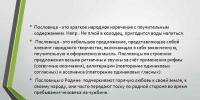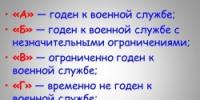Presentations about the basics of medical knowledge. Fundamentals of medical knowledge and rules of first aid. Providing care for wounds

Signs of clinical death Basic Lack of consciousness. Rare shallow breathing less than 8 times per minute or its absence. Absence of pulse in the carotid artery. Additional bluish skin. Attention: In case of carbon monoxide (CO) poisoning, the color of the skin is pink. In case of sodium nitrite poisoning, the skin is violet-bluish. Wide pupils and lack of reaction to light.

Initial examination Approach the victim. Fixing his head with his hand, shake him by the shoulder and ask the question: “What happened?” Rate the victim's level of consciousness using the following scale: Conscious - the victim is able to say his name; your location; day of the week. Responsive to speech - understands speech, but is unable to correctly answer the three questions above. Pain reaction - reacts only to pain. The pain reaction is checked in three ways: 1. pressing on the sternum, 2. squeezing the earlobe, 3. squeezing the victim’s trapezius muscle between the thumb and index finger. No reaction - means that the victim does not respond to speech or pain.

Checking the reaction to painful stimulation: a - pressing on the sternum; b - compression of the trapezius muscle Check the reaction of the pupils to light. Cover the victim's eyes with your palm and open them. Normally, the pupils constrict. Quickly check the victim's ability to move their limbs.


Brief algorithm of actions A-If the airways are obstructed, then restore their patency: finger manipulation, advancement of the lower jaw, two test breaths, as well as the Heimlik maneuver. C-If there is no pulse, begin cardiopulmonary resuscitation in the ratio of 2 breaths - 15 presses. *pulse cardiopulmonary resuscitation

Artificial ventilation CHECKING AND CLEANING THE AIRWAY If the airway is closed, it is necessary to remove foreign objects from the mouth that interfere with breathing. To do this, turn the victim’s head to one side, while also tilting it back, as shown in the picture. Bend the first two fingers with a hook and move them inside the mouth, being careful not to push the foreign object into the larynx. Then check your breathing again


Lay the victim on his back. Open his mouth, clean it of foreign contents, take out the removable dentures (Figure 1). Tilt your head back (Figure 2). Make sure that your tongue does not cover the larynx. Hold the victim’s head and neck with one hand, and pinch his nostrils with the other. Inhale deeply and, pressing your mouth tightly against your mouth through the scarf, exhale vigorously (Figure 3). Do the first 5-10 blows quickly (in 20-30 seconds) and the next ones at a speed of blows per minute. Monitor the movement of the victim’s chest; if after you exhale into the mouth or nose, his chest rises, it means that the airway is passable, and you are doing artificial respiration correctly. Artificial respiration from mouth to nose. Hold the victim's head back with one hand and close his mouth with the other. Inhale deeply and, clasping the victim’s nose with your lips, (through a handkerchief) exhale vigorously. Procedure:

The mouth-to-mouth method of artificial respiration, used for children, is inhaled into the child’s lungs by the rescuer simultaneously through the mouth and nose with a frequency of about 20 breaths per minute. After the first two doses, it is necessary to check whether there is blood circulation. In small children under two years of age, pay more attention to the position of the head to see if it is thrown back too much. Check your airways to ensure they are clear.

Cardiopulmonary resuscitation Cardiopulmonary resuscitation is performed if the victim is not breathing and there is no pulsation of the carotid artery. The main goal of cardiopulmonary resuscitation is to ensure sufficient patency of the airway, breathing and circulation until the diagnosis and subsequent treatment are clarified. External cardiac massage, when performed at a rate of compressions per minute, provides less than 23% (1/4) of normal cardiac output.

Pressing technique Place the heel of your left palm on the lower part of the sternum, two fingers from the xiphoid process. Place the heel of the palm of one hand on top of the other hand two fingers above the xiphoid process, lifting the fingers so as not to touch the ribs. Bend over the victim, keeping your forearms in a strictly vertical position so that your body weight “works.” Don't bend your elbows. Apply vertical pressure to the sternum, lowering it to about 1/3 of the chest thickness. Avoid oscillatory movements of the victim’s body and maintain the rhythm of the massage, ensuring equal intervals of compression and relaxation of the chest. For adults or middle-aged and older children, perform chest compressions per minute. For younger children, perform at least 100 compressions per minute.



When cardiac arrest is combined with respiratory arrest, artificial respiration and cardiac massage are performed simultaneously. Regardless of whether one person or two are providing assistance, 2 quick exhalations into the victim’s mouth or nose alternate with 15 pressures on the sternum. The effectiveness of resuscitation measures is determined by the appearance of a pulse in large arteries, constriction of the pupils, the appearance of a reaction to light, and the restoration of spontaneous breathing. If breathing and cardiac activity are present or restored, the victim in an unconscious or comatose state is placed on his side to prevent suffocation with his own sunken tongue or vomit. The retraction of the tongue is often indicated by breathing that resembles snoring and severely difficult breathing. In many cases, a precordial shock may be sufficient to restore cardiac function. To do this, place the palm of one hand on the lower third of the sternum and apply a short and sharp blow to it with the fist of the other hand. The presence of a pulse in the carotid artery is checked and, if it is absent, they begin external cardiac massage and artificial ventilation of the lungs.

RULES FOR PERFORMING A CLOSED HEART MASSAGE 1. Place the victim on a firm surface, kneel in front of him next to his heart. 2. Place the convex part of your palm along the chest bone (in the upper part of the chest) so that your fingers do not touch the body. Place the other palm on top of your palm and interlace your fingers. Your shoulders should be just above the victim's chest bone, and your arms should be straight or as shown in the picture. 3. Without bending your straight arms, press vertically down on the lower part of the chest bone by 45 centimeters (for an adult). Stop squeezing. Perform 15 techniques with an average frequency of 80 compressions per minute. The rescuer's actions should be rhythmic and smooth, and not sudden jerks. In order to determine the correct speed, count: one - two - three, one - two - three 4. Throw the victim's head back and take two mouth-to-mouth breaths. It is very important that the pressure applied by your hands is applied correctly. 5. After performing 15 compressions and two ventilations (inhalations), check his pulse. Check the pulse every three minutes 6. As soon as a pulse appears, immediately stop external compression. Continue mouth-to-mouth artificial respiration until spontaneous breathing is restored, helping the victim breathe if necessary.


Test for consolidation of educational material Questions: 1) Give the definition of the abbreviation: a-CPR; b-IVL; c-NMS - indirect cardiac massage 2) Signs of respiratory arrest (choose the correct answer): a-absence of pulse in the carotid artery; b-dilated pupils; c-lack of air flow near the mouth and nose 3) Add the 3rd method of checking the pain reaction: a-pressure on the sternum; b-compression of the earlobe 4) Complete the 2nd sentence: a-if there is no breathing, start mechanical ventilation; b-if there is no pulse, ? 5) Give a name to the second method of artificial respiration: a- “mouth to mouth” b-? 6) When is CPR performed? 7) Frequency of pressure on the sternum (choose the correct answer): a-20-30 times per minute. b times per minute once every 5 minutes. 8) Ventilation with NMS is performed in the rhythm of (choose the correct answer): a-3 pressures and 2 breaths; b- 2 breaths and 15 pressures; in-5 breaths and 3 pressures Russian educational portal Lifestyle magazines / g.g. Lifestyle textbook “Fundamentals of medical knowledge” / 10th grade / Smirnov et al. Design: Power Point, MS Word


Fundamentals of medical knowledge and rules of first aid.
Topic: First aid for injuries.

Injury (from the Greek trauma - wound) is damage to the tissues of the human body with a violation of their integrity and functions, caused by external (mainly mechanical, thermal) influence. Wound (open injury) is a violation of the integrity of the skin, mucous membranes with damage to various tissues and organs caused by mechanical stress.

Shallow wounds with damage to only the superficial layers of the skin or mucous membrane, inflicted over a large area with a flat object, are called abrasions , and surface damage caused by a sharp object in the form of a thin line - scratches .

Based on the mechanism of wound infliction, the nature of the wounding object and the amount of tissue destruction, the following are distinguished:
cut
chopped
bitten
firearms




At venous bleeding, dark blood flows out slowly, evenly, in an indirect stream.
At capillary bleeding, blood oozes in drops from the entire wound surface.
Capillary and venous bleeding is stopped by applying a sterile pressure bandage. In case of venous bleeding, the damaged surface should be raised.

When providing first aid at the wound site, it is necessary to stop the bleeding. When treating wounds, precautions must be taken asepsis And antiseptics .
Asepsis - This is a method that prevents microbes from entering the wound during its treatment. When treating wounds, the basic law of asepsis must be observed: everything that comes into contact with the wound must be sterile.
Antiseptics implies a set of measures aimed at destroying microbes on the skin, in a wound or in the body (in general).

When providing first aid for injuries and wounds, taking into account their severity and characteristics, a certain sequence of first aid measures can be distinguished:
For all types of injuries, it is necessary to quickly and carefully transport the victim to the nearest medical facility, and if possible, quickly call a doctor or an ambulance.

“First aid for bleeding” - Sample: Internal bleeding. Three types of bleeding are known: capillary, venous and arterial. Arterial bleeding and first aid. First aid for bleeding. The limb should be elevated. Ways to stop bleeding. Signs of internal bleeding: - pallor, weakness, dizziness, cold sweat.
“Wounds and bleeding” - With bullet wounds, the entrance hole is smaller than the exit hole. Among gunshot wounds, bullets predominate; fragmentation is less common. The effusion of blood from a blood vessel is called hemorrhage. Facial injuries. Classification of bleeding. Injuries to the soft tissues of the scalp are always dangerous.
“First aid for injuries” - Trauma to the pelvic area. If the victim is not breathing, begin resuscitation. If you are forced to transport the victim yourself, call several helpers. It is IMPOSSIBLE to apply splints to the legs if the victim is lying in the “frog” position. Injury to the spine, back. First aid for injuries of the pelvic area, spine, back.
"First Aid" - Man. Equipment. This type of roller is used for head injuries. What are the symptoms of a sprained ligament? Crossword. - What is the structure of the joint? "Hot chair" A student comes to the board, sits on a chair, facing the class, with his back to the board. What is indicated by numbers 1 and 2? - What injury is shown in the picture?
“Medical care for injuries” - Providing first aid for abdominal injuries. Perform immobilization (immobilize the fracture site). Give the victim a pain reliever. Place the victim in an elevated position in a sitting (reclining) position. Providing first aid for a fracture of the pelvic bones. Providing first aid for head or spinal injuries.
“Artificial respiration” - The objectives of such cardiopulmonary resuscitation are to ensure patency of the airways, maintain pulmonary ventilation and blood circulation. Artificial respiration using the “mouth to mouth”, “mouth to nose” method. Theoretical preparation. Ascertainment of clinical death requires immediate and active treatment measures at the scene of the incident.
There are a total of 17 presentations in the topic
Slide 2
Wounds. Characteristics of wounds. P.M.P. Bleeding. Ways to stop bleeding
topic disclosure -
Slide 3
topic: “Wounds, ways to stop bleeding”
Slide 4
Wounds
Wounds are a violation of the integrity of the skin and mucous membranes.
Slide 5
Slide 6
Chopped wounds - caused by a sharp object
Slide 7
Laceration. Characterized by torn edges and a high degree of soiling
Slide 8
Incised wound. This wound is caused by a sharp object
Slide 9
Gunshot wound
Slide 10
Puncture wound. Mainly inflicted with piercing weapons
Slide 11
Providing care for wounds
- Stop the bleeding
- Wash the wound with a disinfectant solution or water
- treat the skin around the wound
- apply a pressure bandage
Slide 12
Injuries to the scalp
Injuries to the soft tissues of the scalp are always dangerous. They may be accompanied by heavy bleeding, damage to the bones of the skull, brain contusion (concussion) or bleeding in the brain (hematoma), the occurrence of cerebral edema and inflammation of the lining of the brain (meningitis, encephalitis).
Slide 13
Giving help
- clean and rinse the wound
- treat the skin around the wound
- stop the bleeding
- apply a bandage (preferably sterile)
- apply cold
- consult a doctor
In all cases of head injury, you should immediately consult a doctor.
Slide 14
Abdominal wounds with prolapse of internal organs
Slide 15
Giving help
- clean and rinse the wound
- apply a bandage to the wound
- put cold on the bandage in the wound area
- take the victim to the hospital as soon as possible
It is unacceptable to hesitate, since there is a great danger of developing peritonitis (inflammation of the peritoneum), then helping the victim will be extremely difficult.
Slide 16
Facial wounds
Any facial injuries are always extremely life-threatening. Firstly, they are usually accompanied by significant bleeding. Secondly, they can cause brain damage. It is also possible to develop a wound infection (first of all, there is a high risk of developing tetanus or rabies if a wound is bitten by a sick animal), damage to nerves and gland ducts (salivary, lacrimal). Ultimately, a facial injury results in the formation of rough, disfiguring scars.
Slide 17
Giving help
- clean and rinse the wound
- stop the bleeding
- treat the skin around the wound
- apply a pressure bandage
- apply cold
Slide 18
- apply a bandage
- give painkiller medicine
- immediately take the victim to an ophthalmologist
- Eye injuries.
Slide 19
Chest wounds
Slide 20
Giving help
- clean and rinse the wound
- treat the skin around the wound
- apply a sealing (occlusive) bandage
- give the victim painkillers
- urgently deliver the victim to a doctor in a half-sitting position
Slide 21
Bleeding
The human body tolerates the loss of only 500 ml of blood without any special consequences. The loss of 1000 ml of blood already becomes dangerous, and the loss of more than 1000 ml of blood threatens a person’s life. If more than 2000 ml of blood is lost, it is possible to save the life of a bleeding person only if the blood loss is immediately and quickly replaced. Bleeding from a large arterial vessel can lead to death within minutes. Therefore, any bleeding should be stopped as quickly and reliably as possible.




